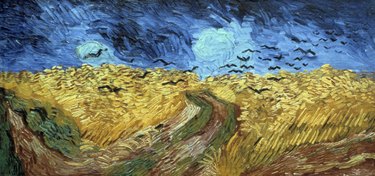
Texture describes how an object feels to the touch. Oil paintings created before the mid-19th century tended to imply texture through use of line, color and shadow, while the paint itself would lie smoothly on the canvas. Nineteenth-century painters such as Vincent Van Gogh, though, changed the concept of texture in painting, applying the color in thick, broad strokes. "Starry Night" is an example of this textured style of brush work.
“Starry Night over Rhone” (1888)
Video of the Day
While living and working in Arles in 1888, Van Gogh painted his first "Starry Night" painting. Called "Starry Night over Rhone," this painting hints at the rough-textured brush strokes to come but is mostly a more traditionally brushed painting. The actual surface of the picture is smooth and well-integrated. The images, though, suggest the texture of a rippling water surface underneath a glittering night sky of stars. The way the texture of the water and reflected starlight are rendered in this painting merely hint at the more elaborate, heavily textured brush work to come.
Video of the Day
The Influence of Paul Gauguin
Van Gogh's work in Arles was influenced by Paul Gauguin, who created his paintings from memory. Van Gogh began to experiment with this process, incorporating thicker brush strokes and bold applications of color. As result, his work took on a fantastical appearance, and he noticed he was able to express his emotional turbulence in his art. The texture of the paintings that emerged in this, Van Gogh's late period of work, revealed thick swirls of paint that stood away from the surface of the picture, mimicking the swirls painted as a part of the picture's image. At this time, Van Gogh entered a phase of painting in which the texture of the paint on the canvas reflected the texture of the image being represented in the painting. This would become Van Gogh's signature painting style, a style famously employed in "Starry Night."
“Starry Night” (1889)
The years 1888 and 1889 were pivotal for Van Gogh. His mental health became more strained. He traveled to an institution in Saint-Remy to seek treatment. There, he painted some of his most memorable work, including the "Starry Night" of 1889. The texture of the bold brush strokes and undulating circles and swoops make the images seem to vibrate on the canvas. The texture here is visually meant to provide the viewer a sense of motion and vibrant light, exaggerating the twinkling of the stars out of realistic proportion. As for the actual texture on the canvas, each swirl and swoop of paint is represented by the brushwork itself, creating a visual texture in perfect sync with the actual texture of the painting.
Legacy of “Starry Night” in Later Work
This marrying of perceived and actual texture in Van Gogh's paintings continued as part of his technique and style until his death in 1890. Some of his most famous late works include "Wheat Field with Crows." In this, perhaps his final painting, Van Gogh uses his brush strokes to create the actual stalks of wheat in the field and the crows flying in the sky. The brush strokes are so thick each of these images are identical to sight and touch.
- Garden of Praise: Self Portrait with Bandaged Ear by Vincent Van Gogh (1853-1890)
- J. Paul Getty Museum: Understanding Formal Analysis
- Artble: Starry Night Critical Reception
- Vincent; The Paintings; “Wheat Field with Crows”
- Loek De Winter: Starry Night
- Seattle University: Art Teacher Toolbox, Vincent Van Gogh
- Mood Book; Art; Vincent Van Gogh